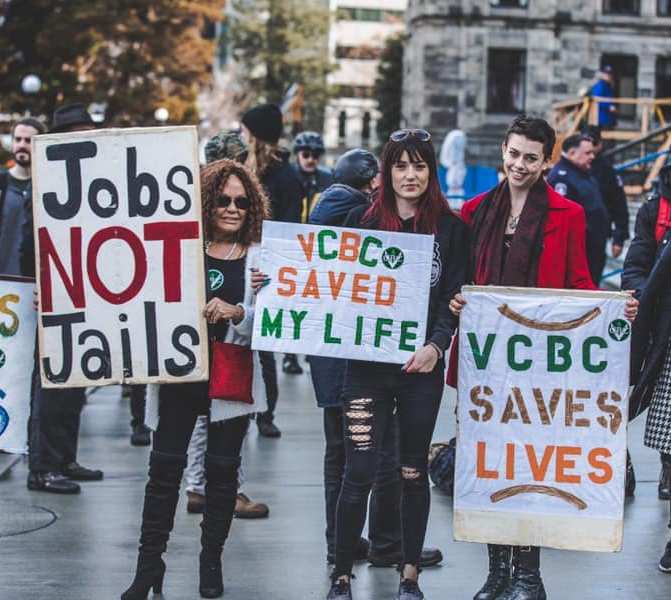Judith Stamps
On December 3 2015, The Arthritis Society, a Canadian national organization, hosted a roundtable discussion in Vancouver BC to identify priorities for medical cannabis research. In the past two years a number of Canadian organizations have held cannabis forums. Among these are The Canadian Consortium for the Investigation of Cannabinoids; Liftcannabis.ca, which hosted three; Sensible BC; Vancouver synagogue Schara Tzedeck; The University of Victoria Students’ Society; The Conscious Living Network; Women Grow, which meets monthly; and the Congregation Emanuel, Victoria’s conservative synagogue. Of these, the Arthritis Society event is unique in two ways. It is the first national-level cannabis forum to come after the federal election, and the first at which attendance was by invitation only. I did not have an invitation. Nonetheless, I have some things to say about the event. Many thanks are due, thus, to our friend and colleague, David Hutchinson, who had an invitation, and who provided some materials and commentary as a starting point.
 The Arthritis Society is a research and advocacy group that serves 4.6 million Canadians. In September 2015, it became the first such organization to create a pamphlet on cannabis: Medical Cannabis: A Guide to Access. The society is conservative, so the pamphlet directs patients exclusively to Licensed Producers (LPs). Founded in 1948, it is Canada’s principal health charity; and with $190 million currently invested in projects, it is Canada’s largest non-governmental funder of medical research. The December 3rd forum benefited from the additional input of $100,000 from Aphria, a publicly traded LP based in Ontario. According to society spokesperson, Joanne Simons, of the patients currently signed up with LPs, 65% are arthritis sufferers. We can have no idea what this number represents. It may reflect the success of the society’s advocacy; or the doctors’ willingness to sign paperwork for people with arthritis; or simply that arthritis is the primary chronic disease out there.
The Arthritis Society is a research and advocacy group that serves 4.6 million Canadians. In September 2015, it became the first such organization to create a pamphlet on cannabis: Medical Cannabis: A Guide to Access. The society is conservative, so the pamphlet directs patients exclusively to Licensed Producers (LPs). Founded in 1948, it is Canada’s principal health charity; and with $190 million currently invested in projects, it is Canada’s largest non-governmental funder of medical research. The December 3rd forum benefited from the additional input of $100,000 from Aphria, a publicly traded LP based in Ontario. According to society spokesperson, Joanne Simons, of the patients currently signed up with LPs, 65% are arthritis sufferers. We can have no idea what this number represents. It may reflect the success of the society’s advocacy; or the doctors’ willingness to sign paperwork for people with arthritis; or simply that arthritis is the primary chronic disease out there.
Present at the roundtable on December 3rd were 50 participants representing 25 groups. The representation, however, was not spread evenly. There were 11 representatives from medical research centres at Canadian universities; 9 from LPs; 7 from The Arthritis Society; 5 from the McGill University based Canadian Consortium for the Investigation of Cannabinoids (CCIC); and 5 from a combination of Health Canada, the Canadian Medical Association, and the BC Ministry of Health. The rest were individuals, one each from groups such as the BC Civil Liberties Association, and the Canadian Centre for Substance Abuse. Jamie Shaw, president of CAMCD, was the lone representative for medical cannabis dispensaries. Veteran American researcher Ethan Russo gave the keynote speech. All present agreed that there is a dearth of research on cannabis, and that research efforts suffer from the stigma associated with it. Judging from its choice of participants, The Arthritis Society’s tactic on this front has been to ally itself almost entirely with medical professionals, government, and government-licensed officials.
 Dearth? If you ask me, we should all be guided David Hepburn’s reminder that cannabis is the most researched medicine on earth, and we should open the access gates forthwith to every earthling with an appropriate diagnosis. But that’s not how the larger research community sees it. Nearly all published cannabis research thus far has been labeled ‘anecdotal,’ and more or less dismissed. US pharmaceutical companies fund over two thirds of medical research in North America, and 70% of continuing medical education courses for MDs. These companies are not required in their publications to compare their drugs with other known treatments (like cannabis), and do not have to publish research that turns out not to please them. According to the Journal of the American Medical Association, studies done on a pharmaceutical company’s behalf by university departments or other research facilities are 3-4 times more likely than more independent studies to favour the company’s medicine. For cannabis research the biggest player is British-based GW Pharmaceuticals, currently in partnership with Bayer. If Wikipedia is to be believed, the company has, since 2012, produced 100 tons of proprietary, cannabis-based medicine. It has also funded and published scores of studies on its meds. There continue to be smaller players out there. But one does get the sense of an incoming tidal wave driven by investors, and friend of the same. Let’s look at a few numbers that pertain to Canada, provided by The Arthritis Society.
Dearth? If you ask me, we should all be guided David Hepburn’s reminder that cannabis is the most researched medicine on earth, and we should open the access gates forthwith to every earthling with an appropriate diagnosis. But that’s not how the larger research community sees it. Nearly all published cannabis research thus far has been labeled ‘anecdotal,’ and more or less dismissed. US pharmaceutical companies fund over two thirds of medical research in North America, and 70% of continuing medical education courses for MDs. These companies are not required in their publications to compare their drugs with other known treatments (like cannabis), and do not have to publish research that turns out not to please them. According to the Journal of the American Medical Association, studies done on a pharmaceutical company’s behalf by university departments or other research facilities are 3-4 times more likely than more independent studies to favour the company’s medicine. For cannabis research the biggest player is British-based GW Pharmaceuticals, currently in partnership with Bayer. If Wikipedia is to be believed, the company has, since 2012, produced 100 tons of proprietary, cannabis-based medicine. It has also funded and published scores of studies on its meds. There continue to be smaller players out there. But one does get the sense of an incoming tidal wave driven by investors, and friend of the same. Let’s look at a few numbers that pertain to Canada, provided by The Arthritis Society.
As of the end of September 2015, Health Canada had received 1,400 LP applications, and is receiving 20 new LP applications each month. Twenty-six are approved; 395 are in process. Together, the LPs have 35,000 patients, with 2-3,000 new patients applying each month, and 6% growth each month, of new prescribing physicians. They’ve made 187,655 shipments, 95% of which are for 3 grams or less of dried flowers, at an average of $8.00 a gram; and hold 7,352 Kg. of available stored bud. There are no comparable publicly available figures on sales for dispensaries and other, less formal sources of medical cannabis. In the present legal climate, there can’t be. But the numbers have to be many times those listed above. Given the bias in medical research, the conservatism of the Canadian Medical Association, and the conservatism in medical advocacy groups, one has to wonder, thus, how our current health minister and her government will come to see the issue. The CMA is particularly worrying. Its guidelines state that cannabis poses a significant risk to memory and cognition, that it can diminish users’ capacity to work and maintain relationships, and that it should not be prescribed for patients who are under 25. Is that view largely the result of the Harper government’s assault on cannabis? Is it the result of the CMA’s own bias on what counts as research? Is this view likely to soften?
 One has to applaud The Arthritis Society. It has shown leadership, and has clearly acknowledged cannabis as a medicine. This is more than one can say for Health Canada…thus far. It is to be hoped that the society’s funds will support useful research. But the December 3rd roundtable event only underscores for me the difficulties cannabis culture will continue to face in the years to come. Here are some of the questions that I would like to see addressed, and that are unlikely to be addressed by medical researchers as they define themselves today. Santa, if you are listening, here is my research question wish list.
One has to applaud The Arthritis Society. It has shown leadership, and has clearly acknowledged cannabis as a medicine. This is more than one can say for Health Canada…thus far. It is to be hoped that the society’s funds will support useful research. But the December 3rd roundtable event only underscores for me the difficulties cannabis culture will continue to face in the years to come. Here are some of the questions that I would like to see addressed, and that are unlikely to be addressed by medical researchers as they define themselves today. Santa, if you are listening, here is my research question wish list.
1. How do patients who use the medicines made by GW Pharmaceuticals fare when compared with similar patients who buy dried cannabis from Canadian LPs?
2. How do patients who buy dried cannabis from Canadian LPs fare when compared to similar patients who buy cannabis and cannabis medicines from medical cannabis dispensaries?
3. How do patients who make their own medicines fare when compared to similar patients who buy ready-made meds from various places?
4. How do patients who grow their own cannabis fare when compared to similar patients who buy it? Are they better or worse at fine-tuning their strains, for example?
5. What proportion of Canadians who would benefit from medical cannabis is able to afford $8.00 a gram?
 6. What is meant by the spiritual uses of Cannabis, and how might we measure that? Can we devise a questionnaire?
6. What is meant by the spiritual uses of Cannabis, and how might we measure that? Can we devise a questionnaire?
7. Does spiritual use, supposing that we can define it, have a healing effect for any illnesses?
8. Of Canadians that use medical cannabis from any source, what percentage discusses it with their physician or specialist?
9. What sorts of things are most likely to influence doctors today? Public opinion? What their patients tell them? What they read in research journals? What Health Canada or the CMA tells them? What they see in the media?
10. Whilst it is true that some kinds of work (dentistry, maybe) should not be combined with cannabis, is there work that could be enhanced by cannabis use? What about landscaping; gardening; playing music; doing artwork; doing handicrafts; raking leaves; cooking; or writing, for example?
11. How does medical cannabis use affect patients’ relationships with their peers? With their kids? With their families?
12. How many Canadians who need cannabis medicine have been damaged physically or psychologically through arrests and prosecutions? How has prohibition in general affected the health of Canadian children, teens, and adults?
These are questions we need to address if we are to be able to see where we stand. It is to be hoped that if dispensaries remain on the new government’s ‘okay’ list, they might be well placed to put some of their resources to work on questions such as these. Numbers indicating the efficacy of cannabis on neuropathic pain, or whatever, will only go so far to undo cannabis-related stigma. Stigma is an intricate knot tied over decades by competing cultural, religious, political and economic interests. A larger, cultural set of issues must be addressed to untangle it.





